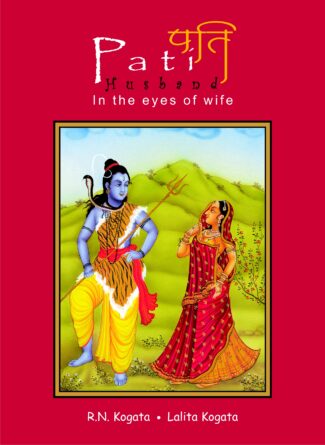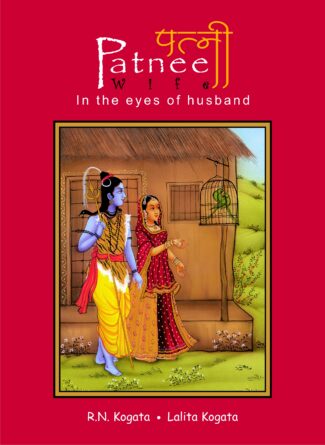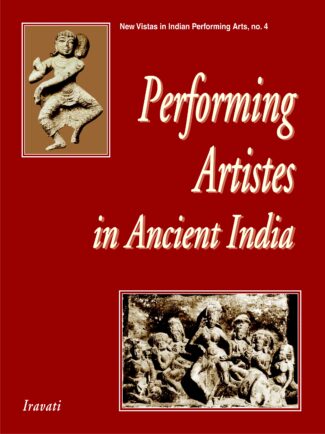Showing 661–670 of 1165 results

This book is a tale centred on the theme of the philosophic ideals and teachings of Vedanta. The story is an interesting account that is not only philosophical but also touches the emotions of the heart. It conveys the deeply founded truths of Vedanta in a simple manner.
This book is a tale centred on the theme of the philosophic ideals and teachings of Vedanta. With a first-person narrative style, it begins with the narrator’s decision to spend the third of the four asramas, the vanaprastha stage of life, in Madurai, the abode of Goddess Meenakshi which has inspired devout scholars and poets for centuries. The tale is an account of the narrator’s study of the philosophy of non-dualism or Advaita, as propounded by masters such as Sri Sankara and Ramana Maharshi, under the guidance of his guru Sankara Shastri. It reveals the nature of the Vedanta philosophy and its significance in understanding the meaning of life and the strange nature of human condition, in attaining peace and bliss in one’s own being and in contributing to harmony and integration in the country. It discusses aspects of creation of the universe and of life, the world and nature around us and the sufferings and pleasures as experienced by humans from a Vedantic perspective.
The story is an interesting account that is not only profoundly philosophical but also touches the emotions of the heart. Readers will be fascinated by this interesting and profound story that conveys the deeply founded truths of Vedanta in a simple manner.

Krishna Steals the Parijata (Parijataharana) tells the story of Krishna forcibly taking away Parijata from Indra to make Satyabhama happy, which finds expression in the paintings of different kalams Chamba, Palam, Early Kangra, Mature Kangra, Bundi, Bikaner and Nepal from different sources.
Krishna Steals the Parijata (Parijataharana) is a collection of a few accounts, edited by Harsha V. Dehejia, on Krishna forcibly taking away Parijata from Indra, which finds expression through the paintings of different kalams. Christopher R. Austin relates this event to the citations and narrations in Mahabharata and Harivamsha, wherein the focus is on Krishnas effort to appease his perturbed wife Satyabhama, by fulfilling her desire to have Parijata from Indras abode. Mahendra Kumar Mishra approaches this incident from Sarala Mahabharata angle. Here the narrative and episode are little different though the centre theme and characters remain the same.
The third narrative is in Hindi by Narmada Prasad Upadyaya. He approaches this story from a different viewpoint that by forcibly taking away the Parijata tree from Indraloka, Krishna broke Indras Himalayan pride. The main characters in the episode are same here too: Krishna, Indra and Satyabhama. In the final article, Harsha V. Dehejia provides a visual narrative account of the event. The story looks almost similar to that of Austin with little more narration and a few additional characters. The sequentially given paintings tell the story faster than the literature.
In a nutshell the book is an exemplar attempt to visually covey a well-known, well-rooted story where Krishna is the central character.

Living as a family is what all human beings even members of the animal kingdom like lion, tiger and elephant do and aspire for. A family togetherness depends upon the role each member plays. A pious couple the Kogatas have seen Lord Shiva’s family as the ideal and have beautified this book with pleasing illustrations of the divine parents and children in different moods followed by charming and delightful verses.
Vasudaiva Kutumbakam — the world is my family. Indian culture teacher us this motto, i.e. to treat all beings, animate and inanimate, in the world as our family members.
Our small family is run by a father and a mother. The father works and earns money, and with it the mother runds the houshold. Both look after the children in the best way possible.
In the Hindu pantheon there is a famous family or Parivaar — that of Lord Shiva comprising his consort Parvati and children Ganesh and Kartik. If we look at the vehicles or vahanas used by this family, we find each one is an enemy or prey of the other, but the composite picture shows a unified family without any sign of animosity. We should take Lord Shivas family as an example.
A family togetherness depends upon the role each member plays, and the members sacrifices, devotion to ideals and respect to family values form the ladder to success.
The Kogatas have also seen Lord Shivas family as the ideal, and have beautified this book with pleasing illustrations of the divine parents and children in different activities and moods, followed by charming and delightful verses.

This volume thus provides the psychological context and the relevance of studies of yoga, based on Patanjalis Yogasutra, for advancing the existing psychological knowledge. Yoga psychology provides the foundation for Indian psychology, an emerging discipline rooted in classical Indian tradition, and enables one to experience self-actualization in life.
Patanjalis Yogasutra: A Psychological Study is an attempt at an English translation of Patanjalis Yogasutra with commentary rendered in current psychological idiom. It features an extensive Introduction to the context and attempts to draw out conclusions on the implications of yoga theory and practices to current psychological knowledge.
Yoga paradigm goes well beyond what is currently in vogue and provides a more fruitful model for studying and understanding human nature, both hidden and manifest. This volume thus provides the psychological context and the relevance of studies of yoga for advancing the existing psychological knowledge. Yoga psychology provides the foundation for Indian psychology, an emerging discipline, rooted in classical Indian tradition.
According to Indian psychology, the person is a unique composite of body, mind and consciousness, making a qualitative distinction between mind and consciousness. Self-actualization, the ultimate aim of a person, is realized by cultivating consciousness as-such, resulting in a kind of psycho-spiritual symbiosis, enabling a person to experience an all-around transformation.

From time immemorial a family Þ consisting of father, mother, son, his wife, and their childern Þ has been accepted as a sacred institution in all societies Þ urban, rural, tribal or uncivilized, or even among animals to a certain extent. In the family, besides love and affection, the main factors cementing the bond between members are some virtues and morals like obedience, faithfulness, honesty, and, above all, chastity, not only for women but also for the men. In Hindu thought Lord Shiva and Goddess Parvati are considered the ideal parents as well as the ideal couple. In four books Þ Pita, Maa, Pati and Patni Þ pleasingly embellished with self-explaining paintings, Mr K.N. Kogata and Mrs Lalita Kogata have extolled the roles, activities, and moods of these important members of the first family with charming and delightful verses.
A man has many roles to play in life a son, brother, husband, householder and father. The most important of these roles is that of husband. Only after becoming a husband a man becomes a householder and father. Epics, Puranas and other literature extol the role of a husband and list a number of dos and don’ts so that he can lead a chaste life and earn virtues and good reputation for himself as well as for his family. It is said that a husband is the source of dream and destination, he sets the way and speed, his positive attitude results in creativity, inspiration and happiness in the family, and for any wife, the husband is the ultimate truth and shrine. This book is a small attempt to express the love, affection, respect and feelings of a wife for her husband with the objective to inspire all men to become caring husbands. In Hindu thought Lord Shiva is considered a perfect husband, and women observe vrats on Mondays and pray that they should get good husbands like Shiva. The Kogatas have beautified the book with pleasing illustrations depicting Shiva as the perfect husband and Uma or Parvati as the perfect wife.

The book contains papers presented at a workshop on patient-physician relationship, organised by Jadavpur University, by thinkers from various disciplines like religion, philosophy and law discussing medical ethics, consent and confidentiality, gender-related differences, etc.
The papers presented at a workshop on ßpatient-physician relationship,û organized by Department of Philosophy, Jadavpur University, have thinkers from various disciplines like religion, philosophy and law discussing a range of issues involved in patient-physician understanding. The concept is viewed in the modern context as well as keeping the indigenous thought tradition in mind. The papers examine the nature and limits of the patient-physician relationship, issues relating to medical ethics, the working of consent and confidentiality, and the link between law and medicine. They look into the role of culture as a determining factor in the patient-physician relationship and the impact of religious beliefs and values on the relationship. They stress the need for a harmonious and balanced relation between the patient and the physician and importance of communication in patient-physician relationship. The experts specially throw light on feminist concerns about medical practice, such as the need for treatment referring to gender-related differences, and examine the way individual characteristics of doctors and patients affect the way they relate to each other. They emphasise on patients being educated and enlightened to be able to exercise their rights. The volume will prove interesting and informative to medical practitioners and researchers as well as general readers.

From time immemorial a family Þ consisting of father, mother, son, his wife, and their childern Þ has been accepted as a sacred institution in all societies Þ urban, rural, tribal or uncivilized, or even among animals to a certain extent. In the family, besides love and affection, the main factors cementing the bond between members are some virtues and morals like obedience, faithfulness, honesty, and, above all, chastity, not only for women but also for the men. In Hindu thought Lord Shiva and Goddess Parvati are considered the ideal parents as well as the ideal couple. In four books Þ Pita, Maa, Pati and Patni Þ pleasingly embellished with self-explaining paintings, Mr K.N. Kogata and Mrs Lalita Kogata have extolled the roles, activities, and moods of these important members of the first family with charming and delightful verses.
A woman has many roles to play in life a daughter, sister, wife and mother. The most important of these roles is that of wife. Only after becoming a wife a woman becomes a mother which brings fullness to her life. Epics, Puranas and other literature extol the imporance of wife to a husband. She is a friend, philosopher and guide to him. In times of plenty all relatives and friends flock to a man like bees and ants to a ripe fruit, but at times of adversity a man will find only his wife by his side to give support, solace and encouragement. Probably because of this characteristic of a wife is she called better half. This book is a small attempt to express the love, affection and feelings of a husband for his wife with the objective to inspire all women to become good and virtuous wives worthy of adoration by their husbands. In Hindu thought Parvati or Uma or Sati is considered an ideal wife, who together with her consort Shiva make a perfect couple or aadarsh dampati. Another made-for-each-other couple the Kogatas have beautified the book with pleasing illustrations of Parvati and Shiva as the ideal couple. The delightful verses add sweetness and charm to the book.

A unique pedagogical method of teaching of Advaita is presented in the Sanskrit trans-creation of Nishcaladasas Vicharasagara and its tippani by Pitambar, by Vasudeva Brahmendra Sarasvati, depending on the need of different types of seekers uttama, madhyama and kanishtha adhikaris simplifying the teaching and learning of Advaita even for laymen.
This book is a critical study of the Sanskrit trans-creation of Vicharasagara by Vasudeva Brahmendra Sarasvati of Nishcaladasa in one of the dialects of Hindi and its tippani by Pitambar, again in the same dialect, imparting a unique teaching technique of Advaita to different types of aspirants. The book thus unfolds the teaching of Advaita depending on the need of different types of seekers uttama, madhyama and kanishtha adhikaris. The volume focuses on two layers of concerns: first, of the appropriate modifications made by the trans-creator using simple Sanskrit and second, in the dialogue between the guru and the different adhikaris.
This critical study introduces us to: (i) the life and works of Nishcaladasa, Pitambar and Vasudeva Brahmendra; (ii) emergence of adhikari-based pedagogy system; and (iii) the employment of pedagogical tools by the guru, depending upon the character and needs of the seeker. The related questions and discussions found in different tarangas of Vicarasagara are pooled in and presented in a cohesive manner to arrive at the core of Nishcaladasas work. It also delves deep into topics such as meditation and its efficacy as a means to gradual liberation, and the nature of liberation.
The book, therefore, introduces the well-defined concepts of Vedanta in a simple pedagogical way as a dialogue between the preceptor and the student, helping even a layman to understand the nuances of Advaita, otherwise a hard subject to digest and grasp.

The author takes a1 critical look at some of the hitherto-unnoticed niceties of Banabhattas Harsacaritam, the Raghuvamsam, Abhijnana-Sakuntalam and other classical Sanskrit plays, against the backdrop of Hemadri and Ranganathas commentaries.
How far has the poetic style of the Vedas influenced the later Sanskrit literature, specially the authors of Brahmanas, Upanishads, and even lexicons? How far do the Dharmashastras, particularly in terms of their value concepts, manifest borrowings from the Ramayana and the Mahabharata? Or, again, how do Dharmashastras view the juridical concepts, like nyasa (deposit) and witness? How, and what for, have Valmiki, Kalidasa, and other classical poets/playwrights used astronomical symbology like, for instance, the phenomenon of Moon-Rohini association, in their writings? How is Professor H.D. Velankars contribution to Vedic Indology, specially Rg-Vedic interpretations, unique in its own right? An eminent Sanskritist, Dr. Moghe addresses these and other Indology-related questions, drawing on his highly specialized studies of Dharmashastras, Purva-Mimamsa philosophy, the Ramayana, the Mahabharata, literary classics and dramaturgic texts. In this composition of 12 writings, of varying lengths, the author discovers fresh linkages between Dharmashastras and Indias foremost epics, highlighting how both the Mahabharata and the Ramayanas ethical/social/legal values found almost universal acceptance with the writers of Dharmasastras, either in their unaltered form or with certain modifications. Among other thematic specificities, A Peep at Indology takes a critical look at some of the hitherto-unnoticed niceties of Banbhattas Harshacaritam, Kalidasas Raghuvamsham and Abhijnana Shakuntalam, and other classical Sanskrit plays against the backdrop of Hemadri and Ranganathas well-known commentaries. Invaluable to the scholars/researchers of Vedic Indology, Dharmashastra literature, and classical Sanskrit.

The book studies the evolution of ancient Indian theatre: it deals with the dramatic troupes, abhinaya, the stage and auditorium and visuals depicting scenes etched on temples and caves. It examines the kinds of performing artistes and their contributions.
Theatre in ancient India or natya incorporated various aspects of art and different branches of knowledge in its very definition not only histrionics but also dance, music and fine arts and branches of learning like history, philosophy and science. This work traces the evolution of the ancient Indian theatre, focusing on the contributions of the performing artistes. This scholarly treatise deals at length with aspects of dramatic performance like nature, kinds and members of dramatic troupes, abhinaya, the stage and auditorium, incorporating a number of visuals to depict the dramatic scenes etched by artists on pillars, temple walls, caves and objects. It classifies the different kinds and levels of performers: actors like Sailusa, Sailalin, Mankh Kusilava, Nata and Bharata, and actresses like professional actresses, courtesan actresses, divine actresses and so on. It refers to Natyasastra and other noted works on dramaturgy and their authors, and gives examples and illustrations from the famous epics, Buddhist and Jain literature and other works like the Arthasastra to throw light on values associated with drama and its actual performance in ancient times. The book, presenting well-researched facts and giving an insightful analysis, will prove useful to researchers and teachers of classical Indian art.
| There are no products |